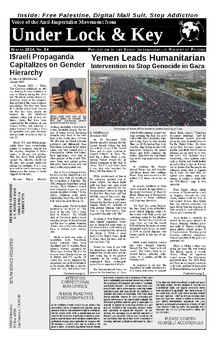
Sex Between Staff and Prisoners in California
The comrade who reported in ULK 40 on a lawsuit around sexual assaults in California prisons(1) wrote back to reiterate that California law prohibits such behavior. "An inmate cannot validly consent to sex with a prison employee", see California Penal Code Section 289.6 and California Code of Regulations Title 15 3401.5. This is actually a good example of a law that tackles Liberalism around the question of rape in one fell swoop by recognizing the systematic relationship between prisoners and state employees that prevents consent.
Despite this law, our comrade documents a history of administrative coverups of sexual abuse of prisoners by staff. Clearly the gender oppressed need more than words on paper to be free of the patriarchy. And for prisoners who "cooperate" with prison administrators, administrative coverups operate in the opposite direction. Our comrade points to Freitag v. Ayers, 463 F.3d 838 (9th Cir.2006), which documents the case of a female correctional officer at Pelican Bay State Prison who was discouraged by her supervisors from filing disciplinary actions against prisoners who would sexually harass her "as a sexual favor to gain [their] cooperation."
In the previous article by this comrade, we pointed out the possibility that New Afrikan bio-males (especially youth) may be considered gender oppressed if one looks at prisons on a statistical level. Yet, we do not deny that bio-male prisoners often play the role of sexual aggressor, both against other male prisoners and female guards. The example of Freitag v. Ayers echoes one of these hypotheticals that our critics threw at us to ask the question, "who is the rapist here?"(2) Yet in this case we see the patriarchy, in the form of the CDCR administration at Pelican Bay, actively enforcing the roles of both the SHU prisoner being held in an isolation cell and the female guard who must endure the prisoner's acting out. The obvious culprit here, and the federal courts agreed, was the patriarchal institution of the CDCR.
Prison is an extreme example, but it helps us see the patriarchy at work. As we said in our previous article on the lawsuit, even when the female guard is the clear aggressor, firing her does not do anything to lesson rape on a group level, though it might help some individuals for a period of time. There are many institutions that serve to enforce the patriarchy throughout our society that serve to undermine the gender oppressed's power over their own bodies. We must build independent institutions that serve the gender oppressed, in order to create a world where sex can be consensual.
A great example of prisoners doing this behind bars is in the organization Men Against Sexism which was in Washington state in the 1970s.(1) Our conditions today are different than those faced by Washington prisoners at the time, but we can still address gender oppression as part of our overall struggle to build unity.








